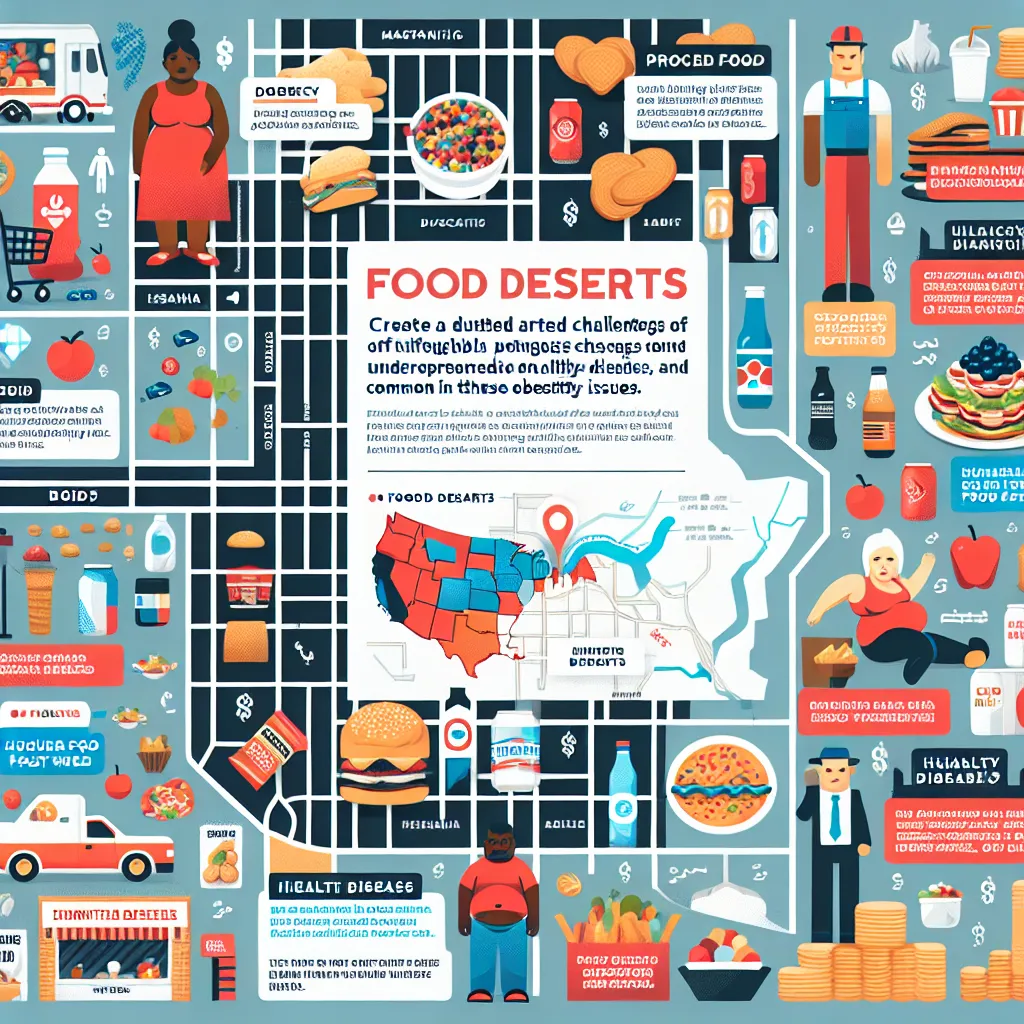The IELTS Reading section is a crucial component of the test, assessing your ability to comprehend complex texts and extract relevant information. Today, we’ll focus on a topic that has gained significant attention in recent years: “The impact of food deserts on public health.” This subject has appeared in various forms in past IELTS exams and continues to be relevant due to its importance in urban planning and public health discussions. Given its ongoing significance, there’s a high likelihood of encountering similar themes in future tests.
 Impact of food deserts on public health
Impact of food deserts on public health
IELTS Reading Practice Test
Reading Passage
The Hidden Hunger: Food Deserts and Their Impact on Public Health
Food deserts, areas characterized by limited access to affordable and nutritious food, have become a growing concern in urban and rural communities alike. These nutritional wastelands disproportionately affect low-income neighborhoods and contribute to a cycle of poor health outcomes that can span generations. The United States Department of Agriculture (USDA) defines a food desert as an area where at least 33% of the population lives more than one mile from a supermarket in urban areas, or more than 10 miles in rural areas.
The proliferation of food deserts is not merely a matter of inconvenience; it represents a significant public health crisis. Residents of these areas often rely on convenience stores and fast-food restaurants for their dietary needs, leading to a diet high in processed foods, saturated fats, and added sugars. This limited access to fresh produce and whole foods has been linked to higher rates of obesity, diabetes, cardiovascular disease, and other diet-related health issues.
The impact of food deserts extends beyond physical health. Studies have shown a correlation between food insecurity and mental health problems, including increased stress, anxiety, and depression. Children growing up in food deserts are particularly vulnerable, as poor nutrition can affect cognitive development and academic performance, potentially limiting future opportunities and perpetuating cycles of poverty.
Addressing the food desert problem requires a multifaceted approach. Some communities have found success in incentivizing grocery stores to open in underserved areas, while others have focused on supporting local farmers’ markets and community gardens. Mobile markets – essentially grocery stores on wheels – have emerged as an innovative solution in some urban areas. Additionally, improving public transportation to connect residents with fresh food sources can help bridge the gap in food access.
Policy makers are increasingly recognizing the need for intervention. Various initiatives, such as the Healthy Food Financing Initiative in the United States, aim to increase access to healthy foods in underserved areas. These programs often provide financial incentives for retailers to open stores in food deserts and support local food production efforts.
Education plays a crucial role in combating the effects of food deserts. Nutritional literacy programs can empower residents to make healthier food choices, even within the constraints of their environment. Teaching cooking skills and the benefits of a balanced diet can help individuals maximize the nutritional value of available foods.
The rise of urban agriculture presents another promising avenue for addressing food deserts. Rooftop gardens, vertical farming, and repurposed vacant lots for food production can bring fresh produce directly into communities that need it most. These initiatives not only improve access to healthy foods but also foster a sense of community and environmental stewardship.
As awareness of food deserts grows, so does the imperative to find sustainable solutions. The health of millions depends on our ability to ensure that all communities have access to affordable, nutritious food. By addressing food deserts, we can take a significant step toward reducing health disparities and improving public health outcomes for generations to come.
Questions
True/False/Not Given
Determine if the following statements are True, False, or Not Given based on the information in the passage.
- Food deserts are exclusively found in urban areas.
- The USDA defines food deserts based on distance from supermarkets and population percentage.
- Residents of food deserts have higher rates of mental health issues.
- All attempts to establish grocery stores in food deserts have been successful.
- Urban agriculture initiatives always lead to improved community relations.
Multiple Choice
Choose the correct letter, A, B, C, or D.
-
According to the passage, food deserts contribute to:
A) Increased property values
B) Higher education levels
C) A cycle of poor health outcomes
D) Greater community cohesion -
Children in food deserts are particularly at risk of:
A) Physical injuries
B) Cognitive development issues
C) Increased social skills
D) Advanced musical abilities -
Which of the following is NOT mentioned as a solution to food deserts?
A) Mobile markets
B) Community gardens
C) Online grocery delivery services
D) Improving public transportation
Matching Information
Match the following statements (9-13) with the correct paragraph (A-H) from the passage.
- The definition of a food desert according to a government agency
- The potential of urban farming in addressing food deserts
- The impact of food deserts on children’s future prospects
- Government initiatives to increase access to healthy foods
- The role of education in mitigating the effects of food deserts
Summary Completion
Complete the summary below using NO MORE THAN TWO WORDS from the passage for each answer.
Food deserts are areas with limited access to (14) and nutritious food. They are prevalent in (15) neighborhoods and contribute to various health problems. Residents often rely on (16) and fast-food restaurants, leading to diets high in (17) and added sugars. This dietary pattern is linked to higher rates of obesity, diabetes, and (18) . Addressing food deserts requires a multifaceted approach, including incentivizing grocery stores, supporting local markets, and improving (19) to connect residents with fresh food sources.
Answer Key and Explanations
True/False/Not Given
- False – The passage mentions that food deserts exist in both urban and rural communities.
- True – The USDA definition includes distance criteria and population percentage (33%).
- True – The passage states that studies have shown a correlation between food insecurity and mental health problems.
- Not Given – The passage mentions success in some communities but doesn’t state that all attempts have been successful.
- Not Given – While urban agriculture is mentioned positively, the passage doesn’t claim it always improves community relations.
Multiple Choice
- C – The passage states that food deserts “contribute to a cycle of poor health outcomes.”
- B – The text mentions that poor nutrition can affect cognitive development in children.
- C – Online grocery delivery services are not mentioned in the passage as a solution.
Matching Information
- A – Paragraph 1 provides the USDA definition of a food desert.
- H – The final paragraph discusses urban agriculture initiatives.
- C – Paragraph 3 mentions the impact on children’s cognitive development and future opportunities.
- E – Paragraph 5 discusses government initiatives like the Healthy Food Financing Initiative.
- F – Paragraph 6 focuses on the role of education in combating food desert effects.
Summary Completion
- affordable
- low-income
- convenience stores
- processed foods
- cardiovascular disease
- public transportation
Common Mistakes to Avoid
- Overlooking key phrases: Pay attention to qualifiers like “some,” “often,” or “can” that may change the meaning of a statement.
- Making assumptions: Stick to the information provided in the text and avoid drawing conclusions based on personal knowledge.
- Misinterpreting Not Given: Remember that Not Given means the information is neither confirmed nor contradicted by the passage.
- Rushing through the text: Take time to understand the overall structure and main ideas of each paragraph.
- Ignoring context: Consider how each sentence relates to the surrounding text to grasp its full meaning.
Vocabulary Focus
- Proliferation (noun) – rapid increase in number or amount
- Disproportionately (adverb) – to a degree that is too large or too small in comparison with something else
- Multifaceted (adjective) – having many different aspects or features
- Incentivizing (verb) – motivating or encouraging someone to do something
- Intervention (noun) – the action of becoming involved in a difficult situation in order to improve it or prevent it from getting worse
- Imperative (noun) – an essential or urgent thing
- Disparity (noun) – a great difference
Grammar Spotlight
Pay attention to the use of present perfect tense in sentences like “Studies have shown a correlation between food insecurity and mental health problems.” This tense is used to connect past actions or situations with the present, indicating ongoing relevance or recent completion.
Expert Tips for IELTS Reading Success
- Practice active reading: Engage with the text by predicting content, asking questions, and summarizing main ideas.
- Improve your vocabulary: Regularly learn new words and phrases related to common IELTS topics like health, environment, and social issues.
- Time management: Allocate your time wisely across all sections of the reading test.
- Skim and scan effectively: Quickly identify main ideas and locate specific information without reading every word.
- Understand question types: Familiarize yourself with different IELTS question formats and practice strategies for each.
- Use context clues: When encountering unfamiliar words, try to deduce their meaning from the surrounding text.
- Stay focused: Maintain concentration throughout the test by practicing with full-length reading passages regularly.
Remember, success in IELTS Reading comes with consistent practice and a strategic approach. By understanding the impact of food deserts on public health, you’re not only preparing for a potential exam topic but also gaining valuable insights into a significant global issue.
For more practice on health-related IELTS topics, check out our articles on the impact of nutrition on public health and the role of community gardens in urban food security. These resources will help you build a strong foundation in vocabulary and concepts related to public health and food accessibility.


